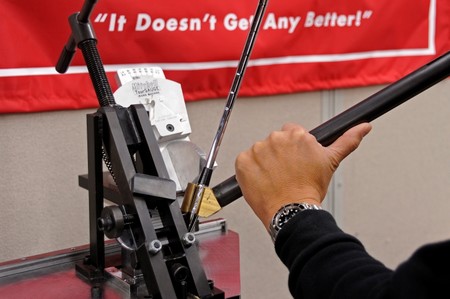Loft
Quite a few amateurs and even professionals are cavalier about lofts, the degree a clubface is angled in relation to the sole. The more loft, the more backspin is imparted on the ball at impact, and the higher its trajectory, and vice versa.
You can customize the loft in your clubs to match your needs. If you hit the ball high, you need less loft. If you hit the ball low, you may require more. As a rule of thumb, lofts should vary from one club to the next in line by about 4°. However, in practice this is not always the case. With some club manufacturers, the loft can vary by plus or minus 2°.
If you have a 7-iron in your bag that you can really hit a mile, and a 6-iron that doesn’t seem to move the ball, they may have lofts for 6.5- and 5.5- irons respectively. You can also end up with two different irons of the same set which have identical lofts.
Loft standards between manufacturers also vary quite a bit, which may account for the fact that your playing partner hits his irons ten yards farther than you. It could just be that his 4-iron has the loft of your 3-iron.
Your professional probably has a loft-and-lie machine, where you can double-check the loft on your clubs to make sure you have the correct loft spacing between clubs.
Lie
The lie of a golf club, when it is properly grounded, is of utmost importance in selecting equipment. It is determined by the shape of the clubhead sole, the angle at which the shaft is attached to the clubhead, and the length of the shaft. As a result, the lie affects the plane and the radius of your swing.
The angle between clubhead and shaft is more acute with the upright lie, therefore lifting the toe of the club off the ground. With the flat lie the angle between clubhead and shaft is wider, therefore lifting the heel off the ground.
The more upright the lie, the straigher you hit the ball, because you swing the club on line with the ball longer this way. The flatter the lie, the wider the arc. It can help you to generate more clubhead speed.
However, if the lie is too upright for your stance, you will tend to hook. If the lie is too flat, you will tend to slice. Furthermore, you will tend to dig the toe with a flat lie. So if you want to err, you should err with an upright lie.
Every golfer tries to address the ball properly, even if the lie of the club doesn’t suit him or her. Consequently, the player will change his stance to suit the lie of the club. This obviously courts disaster. Instead of changing your stance to suit the lie of the club, you need to change the lie of the club to suit your stance.

When trying out new equipment, have a close look at the lie of the club. Do you have to move closer to the ball than usual? Do you have to move away? Do you have to shift the club to the left or right to get it properly soled? If your answer to any of the above is yes, the club has the wrong lie for you.
With the correct lie, the long irons and woods should show a slight gap between the toe of the clubhead and the ground at address, as the shaft tends to bring the toes down on the longer, faster swings. You can easily check the lie of the club by grounding it, and having your playing partner slip a piece of paper under the toe. If the paper passes to about the centre of the clubhead with the long clubs, the lie is right for you. The shorter the irons, the smaller the gap. The wedge should sit almost flat on the ground.